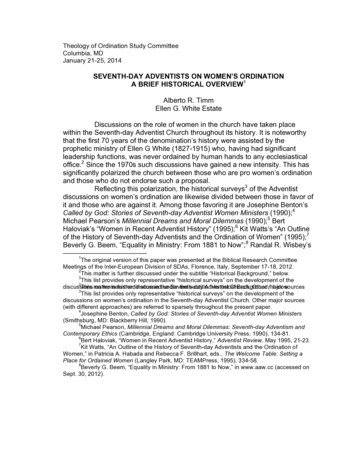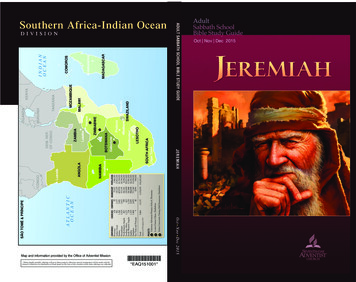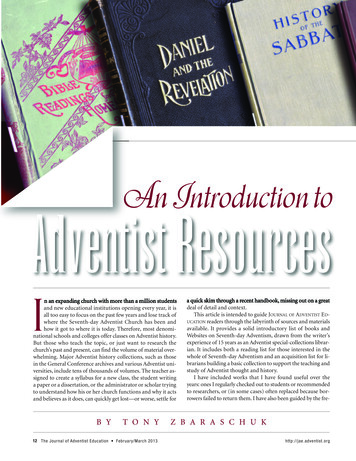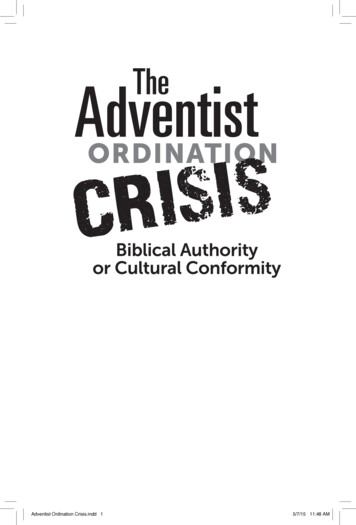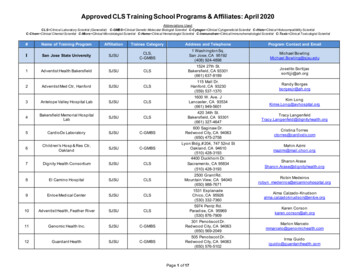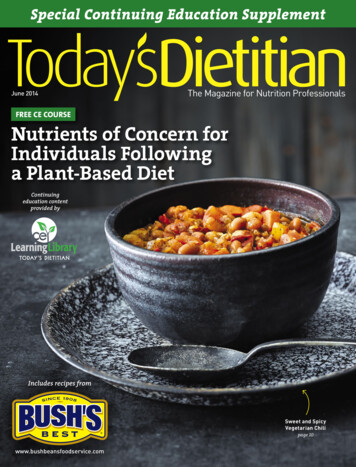
Transcription
REACH the WORLDS T R AT E G I C P L A N 2 0 1 5 – 2 0 2 0REACH UP TO GOD REACH IN WITH GOD REACH OUT WITH GOD
CONTENTS34612142426IntroductionMission Statement of theSeventh-day Adventist ChurchStrategic Issues Emerging FromGlobal Research, 2011–2013The Reach of GraceReach the WorldTimeline: 150 Years of History—and the next five yearsEvaluation and AppendixA B B R E V I AT I O N SACAHCHDAEd.FBKPIMENAMH2Annual Council of the General Conference Executive CommitteeEllen G. White, The Adventist HomeEllen G. White, Counsels on HealthEllen G. White, The Desire of AgesEllen G. White, EducationFundamental Belief (from the Statement of Fundamental Beliefs)Key Performance IndicatorMiddle East and North Africa UnionEllen G. White, The Ministry of Healing
General ConferencePresident’s IntroductionGod’s strategic plan to “reach the world” was unveiled after the fall of our first parents, Adam and Eve. Lovingly,Christ Himself explained to them the plan of salvation and some of its key performance indicators (KPIs), including His coming to earth as a man, dying as a sacrifice for humanity, and rising again. This divine strategic planwas formulated before the creation of the world, and after the fall it was explained and implemented.Before His ascension, Christ’s final words to His disciples reminded them to “reach the world,” making “disciples of allthe nations, baptizing them in the name of the Father and of the Son and of the Holy Spirit, teaching them to observeall things that I have commanded you” (Matthew 28:19, 20, NKJV).The Great Commission of Christ has been a guiding light for His people throughthe centuries and serves as the foundation of this Strategic Plan, 2015–2020, forHis remnant church to reach the world with the Three Angels’ Messages and thewonderful news of Christ’s soon return.This Strategic Plan focuses on the mission statement of the Seventh-day AdventistChurch and our identity and implementation of our mission. By examining thestrategic issues that emerged from global research carried out from 2011 to 2013,specific objectives and KPIs were developed to provide vision and direction incarrying out the church’s special mission.I pray that this document and plan will be an important and useful tool for theentire church as we work unitedly under the guidance of the Holy Spirit to “reachthe world” for Christ.Ted N. C. Wilson, presidentSeventh-day Adventist Church3
Mission Statement of theSeventh-day Adventist ChurchOur MissionThe mission of the Seventh-day Adventist Church is tocall all people to become disciples of Jesus Christ, toproclaim the everlasting gospel embraced in the threeangels’ messages [Revelation 14:6–12], and to preparethe world for Christ’s soon return.Our MethodGuided by the Bible and the Holy Spirit, Seventh-dayAdventists pursue this mission through Christlikeliving, communicating, discipling, teaching, healing,and serving.Our VisionIn harmony with the Bible’s revelations, Seventh-dayAdventists see as the climax of God’s plan the restoration of all His creation to full harmony with Hisperfect will and righteousness.Our IdentityThe Seventh-day Adventist Church sees itself asthe remnant church of end-time Bible prophecy.Members of the church, individually and collectively,understand their special role as ambassadors of God’skingdom and as messengers of the soon return ofJesus Christ. Seventh-day Adventists have enlisted ascoworkers with God in His mission of reclaiming the4world from the power and presence of evil, as part ofthe Great Controversy between Christ and Satan.Therefore, every aspect of a church member’s life isinfluenced by the conviction that we live in the last daysdescribed in Bible prophecy and the return of Jesus Christis imminent. Seventh-day Adventists are called by Godto live in this world. Every action of the Christian life isdone “in the name of Jesus” and to advance His kingdom.Implementation of Our MissionSeventh-day Adventists affirm the Bible as God’sinfallible revelation of His will, accepting its authorityin the life of the church and of each believer, and itsfoundational role for faith and doctrine. Seventh-dayAdventists believe that the Holy Spirit is the powerthat transforms lives and equips people with abilitiesto advance God’s kingdom in this world.Called by God, guided by the Bible, and empowered bythe Holy Spirit, Seventh-day Adventists, wherever welive in the world, devote ourselves to:1. Christlike living—Illustrating the lordship of Jesusin our lives by moral, ethical, and social behaviorsthat are consistent with the teachings and exampleof Jesus.
2. Christlike communicating—Realizingthat all are called to active witness, weshare through personal conversation,preaching, publishing, and the arts,the Bible’s message about God and thehope and salvation offered throughthe life, ministry, atoning death, resurrection, and high priestly ministry ofJesus Christ.3. Christlike discipling—Affirming thevital importance of continued spiritualgrowth and development among allwho accept Jesus as Lord and Savior,we nurture and instruct each otherin righteous living, provide trainingfor effective witness, and encourageresponsive obedience to God’s will.4. Christlike teaching—Acknowledging that development of mind and character is essential to God’sredemptive plan, we promote the growth of a mature understanding of and relationship to God, HisWord, and the created universe.5. Christlike healing—Affirming the biblical principles of the well-being of the whole person, wemake healthful living and the healing of the sicka priority and, through our ministry to the poorand oppressed, cooperate with the Creator in Hiscompassionate work of restoration.6. Christlike serving—Following the example of Jesus,we commit ourselves to humble service, ministering to individuals and populations most affected bypoverty, tragedy, hopelessness, and disease.5
Strategic IssuesEmerging FromGlobal Research,2011–2013REACH the WORLDSTRATEGICISSUES6Note: Over a two-year period, beginning in 2011, five majorresearch projects took place globally. Almost 41,000 churchmembers and nearly 1,000 former church members wereinterviewed or received and completed questionnairesabout their beliefs, attitudes, experiences in the church,and spiritual-life practices. These included 4,260 pastors,almost 1,200 young people (recent graduates of Adventistcolleges and universities in North America), and over 35,000other church members. This unprecedented survey of theworld church was carried out to provide a basis for strategicplanning. In addition, each division and each General Conference department provided its assessment of the strategicpriorities facing them in their part of the world or line ofwork, and each division proposed items that need to beaddressed by the denomination as a whole. Finally, researchundertaken for and presented at two global conferencesheld at the world headquarters (“It’s Time: RefocusingAdventist Urban Mission for the 21st Century” and “Summit on Nurture and Retention: Discipling, Retaining andReclaiming”) was taken into account. This global analysishighlighted a number of positives as well as a number ofareas of concern; the most important are summarized here.The Strategic Plan is founded on this research.
1. Sabbath School emerges as a powerful positive in church life around theworld. The adult Sabbath School lessonsare well liked and regarded as spiritually beneficial in Africa, Latin America,and Asia; Sabbath School teachers areregarded highly by church membersaround the world and so, too, is theoverall experience of Sabbath School.It is a strength on which the churchshould build (including in the area ofnurture and retention; see 3, 4 below).2. Less than half of all Seventh-day Advent ists worldwide have experienced anydenominational education, and manypastors have had limited Adventist education. Thismay be a factor in less-than-satisfactory retentionand a rising variety of views concerning key doctrines (see 4, 7, and 8 below). Although the percentage of church members who have attended Advent ist educational institutions partly reflects rapidchurch growth rather than a lack of commitmentto denominational education, this means there is agrowing need for education for the children of themany new and recent converts. There is also a needfor pastors to receive a thorough and distinctivelyAdventist training and to have opportunities forcontinuing education.3. Many local churches lack robust mechanismsfor member care—especially for those who are atrisk of leaving the church. Local churches needpastors to equip elders and members collectivelyto provide pastoral care for each other. This needemerges from studies of former members, fromsurveys of pastors and church members, and alsofrom denominational statistics. While the numberof church members has grown significantly overthe past fifty years, in the same period, four out often of all members have left. There is an evident7
S T R AT E G I C I S S U E Sneed for comprehensive member-care strategies toenhance the experience in the local church familyand thus improve membership retention patterns.4. As well as improving retention rates, there is also aneed to instill lifelong commitment to membershipin the Seventh-day Adventist Church. Research indicates that in many areas of the world discipleshipprograms should be greatly strengthened, withbaptism being seen as the beginning of a life as afruitful disciple of Jesus Christ.85. Secular thinking and entertainment are affectingAdventist beliefs and practices, especially in theWestern world, but increasingly in other parts ofthe world as well. This was evident from the surveyof church members throughout the world and wasa stated concern in several divisions’ appraisals ofstrategic priorities. Church members urgently needhelp in wisely and biblically evaluating contemporary social trends6. There is a decline in most divisions of personalcommitment to participation in vital personal, familial, and corporate spiritual practices—especiallyin personal Bible study and family worship. Yet frequent, regular personal and familial prayer, Biblestudy, and worship are foundations of the church,and ought to be strongly encouraged.
7. Belief that witches’ powers are real and can legitimately be used by Adventists is relatively high inseveral divisions. Furthermore, significant numbers of Adventists believe that evil spirits havepower even over Christians or accept that spiritsof the dead can communicate with and controlthe living. While the survey of church membersshowed that acceptance of the Adventist doctrineof the state of the dead is high, it is significantlylower than belief in other distinctive doctrines(e.g., the seventh-day Sabbath). The issue of “dualallegiance” should continue to be addressedin relevant regions, while education about theBible’s teachings on the state of the dead shouldbe undertaken globally.8. There is also a significant degree of variation inbelief in other landmark Adventist doctrines,including the imminence of Christ’s secondcoming, the Sanctuary doctrine, and Creation asdescribed in Scripture. Uncertainty and dissent arelow but evident; even pastors are reporting doubts,though not to the same extent as church members.Instruction in doctrine should not be restricted tobaptismal candidates; active discipleship (see 4)should ideally include lifelong learning about thebiblical basis for Adventist doctrines and how theygive a fuller understanding of Christ and salvation.9. It is encouraging to note that belief in EllenWhite’s prophetic gift is very strong all around theworld. However, the proportion of church memberswho report regularly reading her writings is veryThere is a decline in mostdivisions of personalcommitment to participationin vital personal, familial, andcorporate spiritual practices—especially in personal Biblestudy and family worship.9
S T R AT E G I C I S S U E Slow; the proportion that reports reading her dailyis less, in every division, than the proportion thathas never read her writings. The data suggests thatreasons for low reading rates include problemswith distribution and, in some parts of the world,illiteracy. Ellen White’s writings need to be madeavailable more widely to church members in theirown languages.10. Adventist media’s impact within the church is varied; despite some successes, its influence is limitedin many areas. Although it is probably a significantfactor in bringing people into the denomination,it makes less of an impact on those already in thechurch. Relatively low proportions of members report Adventist broadcast, print, and digital mediaas being significant influences on their lives. Theissue in some areas is difficulty in accessing media,more than problems with its content. However,a very large percentage of young people gave lowratings to Adventist social media. Denominationalmedia has unrealized potential for impacting current Seventh-day Adventists.11. The spread of mobile devices, especially smartphones, making access to the Internet ever morewidely available, provides extraordinary opportunities both for widening evangelism and witnessand for responding to the issues identified above:promoting and enriching Bible study, disseminating Ellen White’s writings, and energizing andequipping church members for service.10
12. Research shows that, while actual tithe amountscontinue to increase, faithfulness in tithing isdecreasing. However, relatively few church members have serious doubts about either Adventistteachings on tithing or the way the church usestithes. The research indicates that the easier it isto return tithe, the more likely members are to doso; and that those who regard tithing as part oftheir relationship with Christ are more likely to befaithful in returning tithes.13. There are two ongoing major missional challengesto this movement. First, the countries of the“10/40 Window”—the heartland of the great worldreligions, which in many cases face economic and/or political challenges and have restrictions onreligious liberty. Second, the limited Adventistpresence in large urban areas, especially in NorthAfrica, Europe, the Middle East, and Asia.The challenge of the 10/40 Window wasrecognized by the denomination in1989 and 1990; the needs of largecities were the focus in 2013 of the“It’s Time” conference and anAnnual Council resolution. Yetif the challenges are to be met,the worldwide Seventh-day Adventist Church needs to deploymore financial and personnelresources in the 10/40 Windowand in large urban areas aroundthe world.11
The Reach of Grace“God was in Christ reconciling theworld to Himself” (2 Corinthians 5:19, NKJV).).REACH the WORLDT H E O LO G I C A LF O U N DAT I O N S12The Seventh-day Adventist Church is a worldwidecommunity of believers created by the grace andinitiative of God through the life, death, resurrection, and continuing heavenly ministry of JesusChrist. The mission that called our community intobeing began with the redemptive act of God; it waspursued by God in human history through gifts givenby the Holy Spirit; and it continues as we participatein the divine plan to reconcile to Himself all personsestranged by sin.Believing itself to be the end-time church of Bibleprophecy, the global Seventh-day Adventist Churchjoins in God’s mission by proclaiming and enactingthe three angels’ messages of Revelation 14:6–12. Thefoundational understanding of the church’s remnantidentity arising from this passage causes us to covenant with God and each other to live in a faithfulcommunity that proclaims the priority of worshippingChrist as Creator (verse 7) as Earth approaches its end.We uphold the Bible as the inspired Word of God andteach people of all nations that salvation throughfaith in Him is the only way human beings will everbe judged righteous. As we have “learned Christ” so wefollow after Him in discipleship, separating ourselvesfrom false forms of worship and ungodly practices
We promote ongoingspiritual developmentthat trains and disciplesus for meaningful livesof witness in the world.so that our lives bring Him glory. The urgency of ourproclamation and discipling results from learning thecompassion that caused the Father, Son, and Spirit toengage in Their reconciling mission from “the foundation of the world” (Ephesians 1:4).Seventh-day Adventists continually seek to build upthe remnant church as a community that worshipsJesus faithfully as the Creator (Revelation 14:7) on Hisappointed day, the seventh-day Sabbath. We encourage each other to know God and glorify Him throughpersonal spiritual practices taught in the Word of God,including prayer, meditation, and Bible study. This includes a commitment to lifelong learning as we gatheraround the Word of God for communal study and alsoparticipate in a global system of Christian education.In so doing, we “reach up to God” in loving response tothe salvation offered through Jesus Christ.Seventh-day Adventists also seek to nurture and edifymembers of all ages through spiritual education inboth the truths of Scripture and the habits of Christian lifestyle. This wholistic understanding bringsall aspects of human life under the control of Christ,as we rely on His grace and power to keep His commandments (Revelation 14:12). We promote ongoingspiritual development that trains and disciples usfor meaningful lives of witness in the world. By thesemeans, we “reach in with God” to care for each otherand encourage growth in each other as we patientlywait for Christ’s appearing.Seventh-day Adventists participate in the message of thethird angel of Revelation 14 through multiple forms ofwitness by which we invite persons of all ethnicities andall nations to forsake lives of sin and falsehood and joinGod’s end-time people (Revelation 14:9–12). Because “thelove of Christ compels us” (2 Corinthians 5:14, NKJV),we commit ourselves to announcing the imminenceof Christ’s second coming through public and privateacts that echo the reconciling mission of God in Christ.Our lives promote spiritual and social reconciliation,incarnating the good news of Jesus through deeds ofcaring that meet human needs for health, justice, andpeace. We “reach out with God” as we participate in Hispersistent mission of love and grace.13
O V E R V I E WREACH the WORLDOBJECTIVES141. To involve Adventist members in daily Bible study2. To engage all members in doctrinal study, as essentialfor spiritual maturity3. To make all members better acquainted with EllenWhite’s counsel and prophetic ministry4. To increase the engagement of church members inbiblically authentic spiritual practices5. To foster among pastors, teachers, members, andstudents in denominational institutions, greater appreciation for and insight from a study of Scripturethat uses the historical-grammatical method andhistoricist approach to interpretation, including theunderstanding of prophecy6. To encourage church members to adopt regular patterns of worship
7. To enhance unity and community amongchurch members8. To nurture believers in lives of discipleship andto involve them in service9. To increase the engagement of young people inthe life of the church10. To affirm the administrative role of pastors inorganizational leadership11. To improve leadership practices in order toenhance the credibility of, and trust in, thechurch organization, its operations, andmission initiatives12. To enhance Adventist outreach and presence across the 10/40Window13. To enhance Adventist outreach and presence in large urbanareas worldwide14. To make planting new groups of believers a priority in allparts of the world15. To substantially reorient our understanding and methodsof mission16. To engage all church members, pastors, and leaders in fullpartnership17. To increase the involvement of young people in the missionof the church18. To encourage local churches to take the initiative incommunicating the three angels’ messages and carryingout the mission of the Seventh-day Adventist Church19. To raise the profile of mission to non-Christian religionsand belief systems20. To strengthen the world church’s global resources for mission21. To optimize communication plans and methodologies so asto empower the work and witness of the church15
Reach the WorldActs 2:42, 47I. Because biblical understanding is socentral to our spiritual life and mission:KPIs Significant increases in the numbers of churchmembers regularly engaging in:A. Individual Bible study, by which God speaksto us in meaningful relationshipB. Bible study in family worshipC. Small groupswitchcraft and spiritualism (FB 26, FB 11)C. The church (FB 12, FB 14)D. Second Coming (FB 25)E. Creation (FB 6)F. Sanctuary/Investigative Judgment (FB 24)G. The nature of the Fundamental Beliefs as awhole as Bible-centered doctrines that reflecta loving, gracious GodKPI Improved understanding of and commitment toprinciples of healthful living (FB 22)KPI Increased provision and widespread use of Biblestudy aids on mobile devices and social mediaII. Because biblical doctrines expressuniversal truth, and because researchshows that Adventist understanding ofdoctrines needs attention:III. Because Ellen White’s writings helpus to understand the Bible better andprovide practical and inspired counsel tothe church:OBJECTIVE: To engage all members in doctrinal study,as essential for spiritual maturityOBJECTIVE: To make all members better acquaintedwith Ellen White’s counsel and prophetic ministryKPIs Significant increase in the understanding andacceptance of the church’s Fundamental Beliefs,and in particular of:A. Salvation by faith (FB 10)B. State of the dead and the power of prayer overKPI Increased personal study of her writingsKPI Better understanding of the process of herinspirationKPI Faithful applications of her counsel for thetwenty-first centuryOBJECTIVE: To involve Adventist members in regularBible study16
KPI Increased availability of her writings in locallanguagesKPI Significantly increased availability via mobiledevices and on social media of her writings andof information about her impact and ministryKPI More effective use of social media to promoteEllen White’s writingsIV. Because specific practices nurture andenhance biblical spirituality and safeguardagainst secularism, dual allegiance, andsuperficial religiosity, which researchshows are growing problems in the church:OBJECTIVE: To increase the engagement of churchmembers in biblically authentic spiritual practicesKPIs Significant increase in numbers of church members reporting regular engagement in:A. PrayerB. Meditation upon the life of Jesus and biblicalthemes (DA 82, 83, 207)V. Because the teaching of the Bible shouldhave “our freshest thought, our best methods,and our most earnest effort” (Ed. 186):OBJECTIVE: To foster among pastors, teachers, members, and students in denominational institutions,greater appreciation for and insight from a study ofScripture that uses the historical-grammatical methodand historicist approach to interpretation, includingthe understanding of prophecyKPI Teaching that inspires students to study moredeeply as shown through a systematic examination of how Bible is taught in Adventist schoolsKPI College Bible classes that successfully build confidence in the Bible as divine revelation, trust inGod, and commitment to His missionKPI Seminary and post-seminary training thatensures pastors demonstrate biblical scholarshipthat is faithful to the unique Seventh-dayAdventist understanding of the message andmission of the remnant churchKPI A Bible study curriculum, inclusive of theSabbath School, that is strategically designed toeducate all ages, at successive intervals, in theteachings of the Seventh-day Adventist ChurchVI. Because true worship is a centralelement in our relationship with God, ishighlighted in the three angels’ messages,and is an essential requirement for churchgrowth:OBJECTIVE: To encourage church members to adoptregular patterns of worshipKPIs Significant increase in numbers of church members reporting regular engagement in:A. Personal worshipB. Family worshipC. Corporate worship (Sabbath School andchurch)17
Reach the WorldREACH IN WITH GODActs 2:44–46VII. Because the church is called to be aspiritual community characterized by loveand mutual forbearance, reflecting God’slove and presence:OBJECTIVE: To enhance unity and community amongchurch membersKPI Unity and mutual submission among individualsand people groupsKPI Reclamation of former and inactive membersKPI Pastor-church officer cooperation and teamworkKPI Cross-cultural understanding and respectKPI Implementation of comprehensive, widespread,and practical training in conflict resolutionand reconciliation throughout the worldwidechurchVIII. Because our Christ-given missionis to create communities of faithfuldisciples:OBJECTIVE: To nurture believers in lives of discipleship and to involve them in service18KPI Church members express lifelong commitmentto the church and personal, prayerful involvement in its missionKPI Evidence of increased church-member involvement in service in the church and communityKPI Each division and union has a designated Nurture and Retention coordinator and a Nurtureand Retention committeeKPI Widespread adoption of Seventh-day Adventistmembership software to improve records oflocal church membershipKPI Improved retention rates of audited membershipKPI General Conference departments collaboratingwith one another and in consultation withdivision leaders in creating materials that meetexpressed needs in the areas of nurture, retention, and disciplingKPI Each division holds conferences on nurture,retention, and disciplingKPI Evidence that church members around theworld recognize the need for, and support theroles of, organizational structure for the accomplishment of mission
IX. Because the nurture of young people,with “mighty truths handed down . . . fromgeneration to generation,” is “a sacredtrust” (AH 501):OBJECTIVE: To increase the engagement of youngpeople in the life of the churchKPI All denominational organizations,including local churches, involve youngpeople in decision-making forums, inthe implementation of programs, and inpreparation for leadership rolesX. Because of the vital importance ofpastors in administration and mission:OBJECTIVE: To improve leadership practices in orderto enhance the credibility of, and trust in, the churchorganization, its operations, and mission initiativesKPI The denomination uses a specific orientation process for executive officers of all units of denominational structureKPI Every church entity uses a specific orientationprocess for governing board and executive committee membersKPI All newly elected leaders will complete leadership training, conducted by a higher level oforganizationKPI Administrators and pastors annually completejob-related continuing educationKPI Church membership surveys indicate increasedconfidence in all levels of leadershipOBJECTIVE: To affirm the administrative role of pastors in organizational leadershipKPI Church leaders at all levels include pastors as anintegral part of organizational administrationKPI Pastors are appropriately qualified for their rolesKPI Church members see their pastor as helpingthem to use their time and talents in creativeministryXI. Because the unity of the churchrequires effective, spiritual leadershipand is affected by church members’perception of the competence andaccountability of leaders:19
Reach the WorldREACHOUT WITH GODActs 2:43, 47XII. Because the worldwide Seventh-dayAdventist Church still has yet to makea deep impact in most countries of the10/40 Window:OBJECTIVE: To enhance Adventist outreach and presence across the 10/40 WindowKPI Church planters operating in each country ofthe 10/40 Window where there is currently noSeventh-day Adventist presenceKPI Each conference, mission, and region in the10/40 Window has a five-year plan for achieving a20 percent increase (over five years) in the number of new groups of believersKPI Partnerships created between selected institutionsand mission initiatives in the 10/40 WindowXIII. Because Adventists are not yet“doing the work that should have beendone in these long-neglected cities”(CH 547), in which more than half of theworld’s population now lives:OBJECTIVE: To enhance Adventist outreach and presence in large urban areas worldwide20KPI Twenty percent increase, over five years, in totalaudited membership in urban areas of one million people or moreKPI At least one Center of Influence for every 250,000people in each urban area of one million peopleor moreKPI Improved ratio of membership to population inall urban areas of one million people or moreKPI Improved ratio of worshipping groups to populationin all urban areas of one million people or more
KPI Institutions actively assisting with mission initiatives in urban areas of one million people or moreKPI Interdivisional sponsorship and support functioning for ministry in 100 of the most unentered urban areas of one million people or moreKPI Regular reports being made at General Conference, division, and union midyear and yearendmeetings on progress in reaching the objectivesof the “It’s Time” document (2013 AC)XIV. Because planting new groups ofbelievers has proven its effectivenessas a means of fulfilling the GreatCommission:OBJECTIVE: To make planting new groups of believers a priority in all parts of the worldKPI Each conference, mission, and region outside the10/40 Window has a five-year plan for achieving a30 percent increase (over five years) in the number of new groups of believersXV. Because mission is more than anevent and “Christ’s method . . . in reachingthe people” (MH 143) needs to be morewidely known and followed:OBJECTIVE: To substantially reorient our understanding and methods of missionKPI Every denominational organizational unit has
Seventh-day Adventists affirm the Bible as God’s infallible revelation of His will, accepting its authority in the life of the church and of each believer, and its foundational role for faith and doctrine. Seventh-day Adventists believe that the Holy Spirit is the pow


